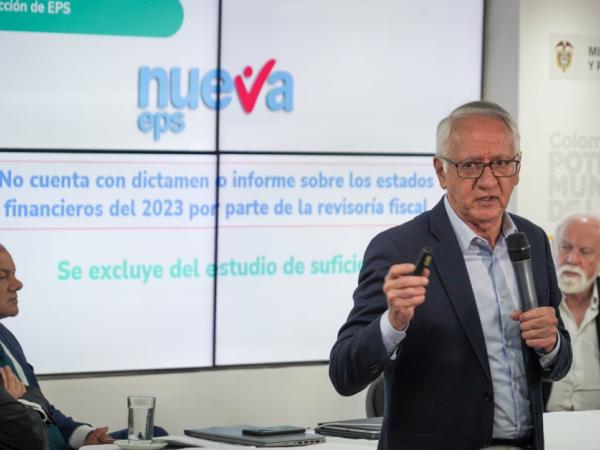Questions about the increase in the Capitation Payment Unit (UPC) continue to be a central issue in the health sector. Given this, the minister Guillermo A. Jaramillo presented the data that supports the 5.36% increase in the premium that finances the system.
(See: Rasa Foundation, on the situation of the health system: ‘the Government does not listen to us’)
Jaramillo explained that the Health Promotion Entities (EPS) did not provide sufficient information to calculate a greater increase. By law, if adequate data is not available, The update must be adjusted to the country’s general inflation. This has generated criticism, as actors in the field assure that these resources will not be enough.
The reception process has information feedback, quality meshes, the expense certificate, the selection of the EPS and finally, The calculation methodology is applied.
(See also: Patients Colombia requests the Attorney General’s Office to protect the fundamental right of health)
In that sense, Jaramillo analyzed that although the UPC for 2025 was close to 1.5 million, its risk adjusters cause the Government to end up allocating additional money for the premium. “Adres ends up paying 30% more for risk adjusters”he explained.
Likewise, he confirmed that none of the EPS of the subsidized regime presented their report, so those of the contributory regime were studied, of which, based on the expense certificate, seven of them were excluded from the study for not passing the qualities or the certification.
Of these, those that were omitted were EEPP of Medellín, Ferrocarriles, Aliansalud EPS, Coosalud EPS, Fundación Salud Mía EPS, Salud Bolívar EPS and Mutual Ser.One came that is the most important, not only because of the number of members but it is the largest, that is, the New EPS. Unfortunately, it did not present financial results for 2023 signed by the tax audit office.”, he indicated.
(Read more: Government warns that fiscal reality limits a further increase in the UPC)
Likewise, it confirmed that Compensar EPS was also excluded, taking into account that a sudden change in the severity pattern in value and frequency was analyzed, situations that still have no basis today. The same was evident in Famisanar.
Healthcare system
iStock
It should be noted that having these three EPS outside the report, they only remained from the contributory regime Total Health, Sanitas, Sura, Comfenalco Valle del Cauca and SOS. Starting from this, the comparison exercise began that studies the external and internal consistency and the financial statements.
From there it was revealed that there were “considerable” differences in the report when compared against the Individual Health Service Provision Records (Rips), mainly for the information provided for 2023. where an increase in frequencies in the sufficiency bases of 62.47% on average was identified, which is not proportional to the increase seen in Rips, which was -1.95% on average.
(See: President Petro refers to the irregularities in data presented by the EPS)
“The frequencies skyrocketed in the eight EPS that passed the quality and certification of spending, on important things such as chemotherapy or transplants. These things have no justification with respect to epidemiological factors“said the Minister.
Now, in the detail of the quality meshes, the portfolio assured that there are users who exceed $100 million in the year, with more than 3 million activities, which had a cost equivalent to $3.5 billion. “That goes out of the context of what statistics should be,” Jaramillo reflected.
Also, he mentioned that in terms of internal consistency it was reflected that when applying “new quality filters” several of The EPS reported activities with a date after the change of status to deceased.
(Read more: Right to petition seeks to revoke resolution on UPC by 2025)
Of the total, 244,347 reports were made to the Ministry, with at least 23,410 deceased people, which amounted to $79,838 million. “You do not have to be reporting after a person has been declared dead. These are other irregularities that we found”, he denounced.

New EPS
Luis Lizarazo García. EL TIEMPO Archive
Atypical procedures and medications
For this front, Guillermo A. Jaramillo explained that in the study of deviations and atypicalities of procedures, for example, for the specific case of central catheter insertion, which is generally done in the jugular, The average cost is equivalent to a little more than a million pesos, however, the deviation was $11 million and in extreme cases up to $331 million have been paid.
(See also: Bad calculation by the UPC condemns health to start 2025 with a serious deficit)
“There cannot be such large deviations. More than 60% of the total value paid for events, which is equivalent to nearly $6 billion, corresponds to CUPS with a high heterogeneity in the reported values, with a coefficient of variation greater than 100%”, estimated Jaramillo.
Regarding medications, it was established that in this same analysis, only 3% of the CUMs reported were in a health registration status different from the current one or the renewal process. In addition, 23% of those who reported the EPS do not have sales information from the pharmaceutical laboratory in Sismed. “Which translates to more than $985 million and 11% of the total reported value,” he said.
(Read more: The inconsistencies detected by the Minsalud in the data reported by the EPS)
Also, he detailed that there was a non-compliance with the regulation of drug prices in more than 2.5 million records, which means $138,000 million in excess of the regulated value.

Health
iStock
work tables
According to Jaramillo, the presidency of the republic decreed the consolidation of financial working groups, with the Superintendence of Health, so that The EPS of the system will report their costs and study their situation.
(See: Afidro warns that the UPC should have increased to 16.4%)
In that sense, the head of the portfolio estimated that there are also differences in the sufficiency costs versus those reported by the EPS, in the work tables, compared to what is given for the Ministry. For example, he presented the case of Total Health, where costs of $4 billion were reported to the portfolio, but a little more than $3 billion to the tables.
“There can be no difference in those who report to us at the tables, in contrast to what was presented to the Ministry to carry out the UPC study. It’s fine that they are thousands of pesos, but billions of pesos, no.”, he noted.
(Read more: Criticism grows against the increase in the UPC for 2025)
Thus, specifically, it was presented that the total certified spending in 2023 was $38.4 billion, but what was reported to the tables was $35.3 billion, that is, a difference of a little more than $3 billion. In addition, from what was recorded by EPS for Supersalud reported an expense to the Ministry of $38.4 billion, while to the Superintendency it was $34.4 billion, with a difference of $3.99 billion..


















